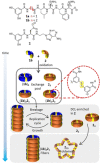Self-Sorting in Dynamic Combinatorial Libraries Leads to the Co-Existence of Foldamers and Self-Replicators
- PMID: 33949062
- PMCID: PMC8252005
- DOI: 10.1002/anie.202101052
Self-Sorting in Dynamic Combinatorial Libraries Leads to the Co-Existence of Foldamers and Self-Replicators
Abstract
Nature segregates fundamental tasks such as information storage/transmission and catalysis between two different compound classes (e.g. polynucleotides for replication and folded polyamides for catalysis). This division of labor is likely a product of evolution, raising the question of how simpler systems in which replicators and folded macromolecules co-exist may emerge in the transition from chemistry to biology. In synthetic systems, achieving co-existence of replicators and foldamers in a single molecular network remains an unsolved problem. Previous work on dynamic molecular networks has given rise to either self-replicating fibers or well-defined foldamer structures (or completely un-sorted complex systems). We report a system in which two cross-reactive dithiol (nucleobase- and peptide-based) building blocks self-sort into a replicator fiber and foldamer that both emerge spontaneously and co-exist. The self-sorting behavior remains prevalent across different building block ratios as two phases of emergence occur: replicator growth followed by foldamer formation. This is attributed to the autocatalytic formation of the replicator fiber, followed by enrichment of the system in the remaining building block, which is subsequently incorporated into a foldamer.
Keywords: dynamic combinatorial chemistry; foldamers; self-assembly; self-replicators; self-sorting.
© 2021 The Authors. Angewandte Chemie International Edition published by Wiley-VCH GmbH.
Conflict of interest statement
The authors declare no conflict of interest.
Figures




References
Publication types
LinkOut - more resources
Full Text Sources
Other Literature Sources

